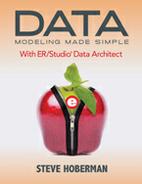My “Top 10” Favorite Features of ER/Studio
- Intuitive. I found ER/Studio to be very easy to learn. The commands I was looking for seemed to be where I expected to find them. I think this is due in part to being very comfortable with the Microsoft Windows environment and ER/Studio having been built with a high degree of consistency with products like Microsoft Word® and navigation like Microsoft Explorer®. I also like that the list of possible commands from the menus changes based on what I am working on. For example, highlighting an entity would bring up entity-specific commands under the menus.
- Cannot start with physical. To promote sound software development practices, ER/Studio does not permit creating a physical data model from scratch. Instead the physical data model must be based upon an existing logical data model or reverse engineered from an existing database (such as the actual database or data definition language such as SQL). More on this in Chapter 10, Physical Data Models.
- Modeler Explorer. The Modeler Explorer window is extremely useful and intuitive. In most modeling tools, I close all of the windows except for my diagram window to maximize real estate for the diagram. In ER/Studio, however, I find that I keep Modeler Explorer open during my modeling because it is an extremely quick and user-friendly way to navigate or modify a data model.
- Level of customization. The level of customization with ER/Studio is extremely impressive. For example, Tools > Options brings up an incredible number of settings that can be changed to personalize the display, enforce rules on the model, facilitate SQL generation, etc. You will learn more about this powerful feature throughout the book.
- Lineage. You can document and view mappings right in ER/Studio, as well as use ER/Studio Data Lineage, which is a separate tool in the ER/Studio XE family that allows you to explore existing or proposed Extraction, Transformation and Load (ETL) mappings to quickly and accurately perform impact analysis. As a data modeler, I believe we are responsible for not just the models, but also the mappings. ER/Studio allows you to capture the mappings. Chapter 12 is completely dedicated to lineage.
- Universal Naming Utility. Using the Universal Naming Utility, you can globally search for, and replace if desired, names, strings, and attachment value overrides for bound attachments. You define your search, and then confine the search to specific objects within your models. More on this in Chapter 4 on finding entities and Chapter 6 on finding attributes.
- Help! The User Guide in ER/Studio is extremely comprehensive. In addition, hitting <F1> or selecting help from the Help menu or on any of the screens, brings up detailed and hyperlinked information straight from the User Guide. The documentation is informative and explains many of the more advanced features of ER/Studio. If you would like more details on any ER/Studio feature as you go through this text, just hit <F1>.
- Version compatibility. ER/Studio can load models from earlier versions, and even load newer versions into an earlier version of the product. This is such a nice feature, especially if you work for an organization that does not migrate to the latest version all at once, or has models created in older versions that were never upgraded.
- Macros. ER/Studio comes shipped with over 50 macros, and also provides you with the functionality to edit these existing macros, as well as create your own. These macros can save you lots of time and improve data consistency within your organization.
- Data Dictionary. Even without using the Repository, you can share domains, rules, reference values, and other valuable types of metadata across models using the Data Dictionary.
..................Content has been hidden....................
You can't read the all page of ebook, please click here login for view all page.
